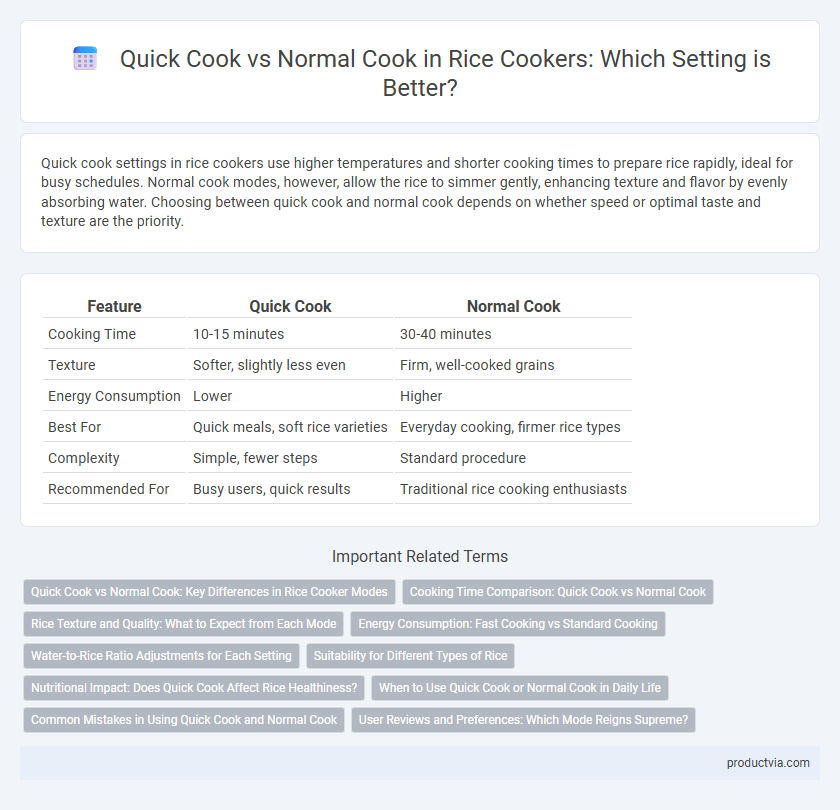Quick cook settings in rice cookers use higher temperatures and shorter cooking times to prepare rice rapidly, ideal for busy schedules. Normal cook modes, however, allow the rice to simmer gently, enhancing texture and flavor by evenly absorbing water. Choosing between quick cook and normal cook depends on whether speed or optimal taste and texture are the priority.
Table of Comparison
| Feature | Quick Cook | Normal Cook |
|---|---|---|
| Cooking Time | 10-15 minutes | 30-40 minutes |
| Texture | Softer, slightly less even | Firm, well-cooked grains |
| Energy Consumption | Lower | Higher |
| Best For | Quick meals, soft rice varieties | Everyday cooking, firmer rice types |
| Complexity | Simple, fewer steps | Standard procedure |
| Recommended For | Busy users, quick results | Traditional rice cooking enthusiasts |
Quick Cook vs Normal Cook: Key Differences in Rice Cooker Modes
Quick cook mode in rice cookers significantly reduces cooking time by using higher temperatures and increased pressure, making it ideal for busy schedules. Normal cook mode follows traditional cooking heat cycles at lower temperatures, preserving the texture and flavor of rice through gradual steaming and absorption. Understanding these key differences helps users select the optimal rice cooker mode for either convenience or culinary quality.
Cooking Time Comparison: Quick Cook vs Normal Cook
Quick cook mode in rice cookers significantly reduces cooking time, typically preparing rice in 15-20 minutes compared to the 30-40 minutes required in normal cook mode. This faster option uses higher heat and pressure settings to accelerate the cooking process without compromising the texture of the rice. Normal cook mode allows for more evenly cooked rice by gradually absorbing water, which enhances flavor and ensures a fluffier consistency.
Rice Texture and Quality: What to Expect from Each Mode
Quick cook mode on rice cookers produces rice with a softer texture and slightly less distinct grains due to the accelerated cooking process, often preferred for convenience but at the expense of optimal quality. Normal cook mode allows rice to absorb water more evenly, resulting in fluffy, well-separated grains with enhanced flavor and texture. Choosing the appropriate mode depends on the desired balance between cooking time and rice quality.
Energy Consumption: Fast Cooking vs Standard Cooking
Quick cook mode in rice cookers significantly reduces cooking time by operating at higher temperatures and increased power, leading to a temporary spike in energy consumption. Standard cooking cycles consume energy more steadily over a longer duration, resulting in overall lower peak power usage but extended energy draw. Choosing quick cook mode can save time but may use slightly more energy per use compared to the stable and energy-efficient standard cooking mode.
Water-to-Rice Ratio Adjustments for Each Setting
Quick cook settings in rice cookers require less water compared to normal cook settings, typically reducing the water-to-rice ratio by about 10-15% to speed up cooking time without sacrificing texture. Normal cook settings allow for a higher water-to-rice ratio, around 1.5 to 2 cups of water per cup of rice, ensuring thorough absorption and softer grains. Adjusting water amounts based on the chosen setting prevents undercooked or mushy rice and optimizes results for each cooking mode.
Suitability for Different Types of Rice
Quick cook mode in rice cookers is ideal for white rice varieties like jasmine and basmati, providing faster cooking times without compromising texture. Normal cook mode suits brown rice, wild rice, and mixed grains, allowing longer cooking that ensures thorough hydration and optimal flavor development. Choosing the appropriate setting enhances the cooking quality based on rice type and texture preferences.
Nutritional Impact: Does Quick Cook Affect Rice Healthiness?
Quick cook settings in rice cookers reduce cooking time by using higher temperatures and pressure, which can slightly degrade heat-sensitive nutrients like some B vitamins compared to normal cooking. Despite this, the overall macronutrient content, including carbohydrates, proteins, and minerals, remains largely unchanged between quick cook and regular cook methods. Choosing quick cook might sacrifice minimal nutritional value but offers practicality without significantly compromising the health benefits of rice.
When to Use Quick Cook or Normal Cook in Daily Life
Quick cook mode in rice cookers is ideal for busy mornings or when you need rice prepared fast, cutting cooking time by up to 30% while sacrificing some texture quality. Normal cook mode suits meals where fluffy, evenly cooked rice is important, such as family dinners or dishes requiring perfect grain separation. Choose quick cook for convenience and speed; opt for normal cook to achieve optimal taste and texture in everyday meals.
Common Mistakes in Using Quick Cook and Normal Cook
Using the Quick Cook setting on rice cookers often leads to undercooked rice due to insufficient absorption time, while Normal Cook can cause overcooking if water ratios are not properly adjusted. Common mistakes include neglecting to rinse rice thoroughly before cooking and using incorrect water-to-rice proportions, which impact texture and flavor. Ensuring precise measurements and following specific instructions for each mode prevents mushy or hard rice outcomes.
User Reviews and Preferences: Which Mode Reigns Supreme?
User reviews reveal a strong preference for quick cook mode in rice cookers due to its time-saving benefits and satisfactory rice texture for daily meals. Normal cook mode often receives praise for producing fluffier, evenly cooked rice, appealing to those prioritizing taste and texture over speed. Overall, quick cook mode reigns supreme among users valuing convenience, while normal cook mode is favored by rice connoisseurs seeking optimal culinary results.
Quick cook vs normal cook for rice cookers Infographic

 productvia.com
productvia.com